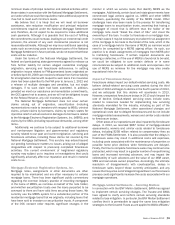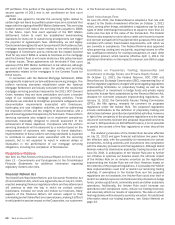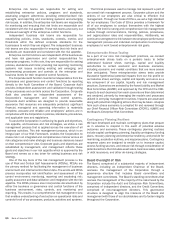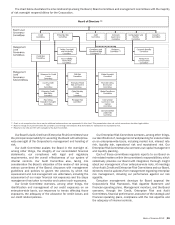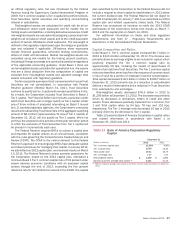Bank of America 2012 Annual Report Download - page 68
Download and view the complete annual report
Please find page 68 of the 2012 Bank of America annual report below. You can navigate through the pages in the report by either clicking on the pages listed below, or by using the keyword search tool below to find specific information within the annual report.66 Bank of America 2012
Strategic Risk Management
Strategic risk is embedded in every business and is one of the
major risk categories along with credit, market, liquidity,
compliance, operational and reputational risks. It is the risk that
results from adverse business decisions, ineffective or
inappropriate business plans, or failure to respond to changes in
the competitive environment, business cycles, customer
preferences, product obsolescence, regulatory environment,
business strategy execution and/or other inherent risks of the
business. Other inherent risks of the business include reputational
and operational risk. In the financial services industry, strategic
risk is elevated due to changing customer, competitive and
regulatory environments. Our appetite for strategic risk is
assessed within the context of the strategic plan, with strategic
risks selectively and carefully considered in the context of the
evolving marketplace. Strategic risk is managed in the context of
our overall financial condition and assessed, managed and acted
on by the CEO and executive management team. Significant
strategic actions, such as material acquisitions or capital actions,
require review and approval by the Board.
Executive management approves a strategic plan each year.
Annually, executive management develops a financial operating
plan that implements the strategic goals for that year, which is
reviewed and approved by the Board. With oversight by the Board,
executive management ensures consistency is applied while
executing the Corporation’s strategic plan, core operating tenets
and risk appetite. The following are assessed in their reviews:
forecasted earnings and returns on capital, the current risk profile,
current capital and liquidity requirements, staffing levels and
changes required to support the plan, stress testing results, and
other qualitative factors such as market growth rates and peer
analysis. At the business level, as we introduce new products, we
monitor their performance to evaluate expectations (e.g., for
earnings and returns on capital). With oversight by the Board,
executive management performs similar analyses throughout the
year, and evaluates changes to the financial forecast or the risk,
capital or liquidity positions as deemed appropriate to balance
and optimize between achieving the targeted risk appetite,
shareholder returns and maintaining the targeted financial
strength.
We use proprietary models to measure the capital requirements
for credit, country, market, operational and strategic risks. The
economic capital assigned to each business is based on its unique
risk exposures. With oversight by the Board, executive
management assesses the risk-adjusted returns of each business
in approving strategic and financial operating plans. The
businesses use economic capital to define business strategies,
price products and transactions, and evaluate client profitability.
For additional information on how this measure is calculated, see
Supplemental Financial Data on page 31.
Capital Management
The Corporation manages its capital position to maintain sufficient
capital to support our business activities and maintain capital,
risk and risk appetite commensurate with one another. Additionally,
we seek to maintain safety and soundness at all times including
under adverse conditions, take advantage of organic growth
opportunities, maintain ready access to financial markets,
continue to serve as a credit intermediary, remain a source of
strength for our subsidiaries, and satisfy current and future
regulatory capital requirements.
To determine the appropriate level of capital, we assess the
results of our Internal Capital Adequacy Assessment Process
(ICAAP), the current economic and market environment, and
feedback from key stakeholders including investors, rating
agencies and regulators. Based upon this analysis, we set
guidelines for capital ratios to maintain an adequate capital
position, including in severe adverse economic scenarios.
Management and the Board annually approve a comprehensive
capital plan which documents the ICAAP and related results,
analysis and support for the capital guidelines, and planned capital
actions.
The ICAAP incorporates capital forecasts, stress test results,
economic capital, qualitative risk assessments and assessment
of regulatory changes. Throughout the year, we generate regulatory
capital and economic capital forecasts that are aligned to the most
recent earnings, balance sheet and risk forecasts. We utilize
quarterly stress tests to assess the potential impacts to our
balance sheet, earnings, capital and liquidity of a variety of stress
scenarios. We perform qualitative risk assessments to identify
and assess material risks not fully captured in the forecasts, stress
tests or economic capital. We regularly assess the capital impacts
of proposed changes to regulatory capital requirements.
Management regularly assesses ICAAP results and provides
documented quarterly assessments of the adequacy of the capital
guidelines and capital position to the Board or its committees.
Capital management is integrated into our risk and governance
processes, as capital is a key consideration in the development
of the strategic plan, risk appetite and risk limits. Economic capital
is allocated to each business unit and used to perform risk-
adjusted return analyses at the business unit, client relationship
and transaction levels.
Regulatory Capital
As a financial services holding company, we are subject to the risk-
based capital guidelines (Basel 1) issued by federal banking
regulators. At December 31, 2012, we operated banking activities
primarily under two charters: BANA and FIA Card Services, N.A.
(FIA). Under these guidelines, the Corporation and its affiliated
banking entities measure capital adequacy based on Tier 1
common capital, Tier 1 capital and Total capital (Tier 1 plus Tier
2 capital). Capital ratios are calculated by dividing each capital
amount by risk-weighted assets. Additionally, Tier 1 capital is
divided by adjusted quarterly average total assets to derive the
Tier 1 leverage ratio.
Tier 1 capital is calculated as the sum of “core capital
elements,” the principal components of which are qualifying
common shareholders’ equity and qualifying non-cumulative
perpetual preferred stock. Also included in Tier 1 capital are
qualifying trust preferred securities (Trust Securities), hybrid
securities and qualifying noncontrolling interest in subsidiaries
which are subject to the rules governing “restricted core capital
elements.” Goodwill, other disallowed intangible assets,
disallowed deferred tax assets and the cumulative changes in fair
value of all financial liabilities accounted for under the fair value
option that are included in retained earnings and are attributable
to changes in the company’s own creditworthiness are deducted
from the sum of the core capital elements. Total capital is the sum
of Tier 1 plus supplementary Tier 2 capital elements such as
qualifying subordinated debt, a limited portion of the allowance
for loan and lease losses, and a portion of net unrealized gains
on AFS marketable equity securities. Tier 1 common capital is not





